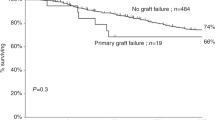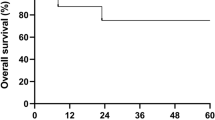Summary:
The histiocytoses are rare disorders of antigen-processing phagocytic or antigen-presenting cells. Allogeneic bone marrow transplantation (BMT) can be curative of these disorders. We report a series of five children with Langerhans cell histiocytosis (n=2) or hemophagocytic lymphohistiocytosis (n=3), who received allogeneic BMT with a total body irradiation (TBI)-containing regimen (TBI, cytarabine, and cyclophosphamide) at our institution between 1995 and 2000. One of these patients received busulfan, cyclophosphamide, and etoposide for the first of two BMTs. All grafts except one (a matched sibling-donor graft) were T-cell-depleted grafts from unrelated donors. All received cyclosporine graft-versus-host disease (GvHD) prophylaxis; the recipient of the matched sibling graft also received methotrexate. Three patients engrafted at a median of 24 days after transplantation. The patient who did not receive TBI experienced primary graft failure and recurrent disease. After the TBI-containing conditioning regimen was given, a second transplant engrafted on day +17. One patient with concurrent myelodysplastic syndrome died of toxicity on day +33 without evidence of engraftment. No acute or chronic GvHD was observed. Four patients survive disease-free, a median of 63 months after transplantation, all with Lansky performance scores of 100. We conclude that a conditioning regimen containing TBI but not etoposide is effective in allogeneic BMT for children with histiocytic diseases.
This is a preview of subscription content, access via your institution
Access options
Subscribe to this journal
Receive 12 print issues and online access
$259.00 per year
only $21.58 per issue
Buy this article
- Purchase on Springer Link
- Instant access to full article PDF
Prices may be subject to local taxes which are calculated during checkout
Similar content being viewed by others
References
Stephan JL . Histiocytoses. Eur J Pediatr 1995; 154: 600–609.
Henter JI, Arico M, Elinder G et al. Familial hemophagocytic lymphohistiocytosis. Hemophagocytic lymphohistiocytosis. Hematol Oncol Clin North Am 1998; 12: 417–433.
Janka GE . Familial hemophagocytic lymphohistiocytosis. Eur J Pediatr 1983; 140: 221–230.
Dufourcq-Lagelouse R, Pastural E, Barrat FJ et al. Genetic basis of hemophagocytic lymphohistiocytosis syndrome. Int J Mol Med 1999; 4: 127–133.
Gadner H, Heitger A, Grois N et al. Treatment strategy for disseminated Langerhans cell histiocytosis. Med Pediatr Oncol 1994; 23: 72–80.
Titgemeyer C, Grois N, Minkow M et al. Pattern and course of single-system disease in Langerhans cell histiocytosis data from the DAL-HX 83- and 90-study. Med Pediatr Oncol 2001; 37: 108–114.
Morgan G . Myeloablative therapy and bone marrow transplantation for langerhans' cell histiocytosis. Br J Cancer 1994; 23 (Suppl): S52–S53.
Stoll M, Freund M, Schmid H et al. Allogeneic bone marrow transplantation for Langerhans' cell histiocytosis. Cancer 1990; 66: 284–288.
Ringden O, Lonnqvist B, Holst M . 12-year follow-up of allogeneic bone-marrow transplant for Langerhans’ cell histiocytosis. Lancet 1997; 349: 476.
Conter V, Reciputo A, Arrigo C et al. Bone marrow transplantation for refractory Langerhans’ cell histiocytosis. Haematologica 1996; 81: 468–471.
Suminoe A, Matsuzaki A, Hattori H et al. Unrelated cord blood transplantation for an infant with chemotherapy-resistant progressive Langerhans cell histiocytosis. J Pediatr Hematol Oncol 2001; 23: 633–636.
Nagarajan R, Neglia J, Ramsay N, Baker KS . Successful treatment of refractory langerhans cell histiocytosis with unrelated cord blood transplantation. J Pediatr Hematol Oncol 2001; 23: 629–632.
Arico M, Janka G, Fischer A et al. Hemophagocytic lymphohistiocytosis. Report of 122 children from the International Registry. Leukemia 1996; 10: 197–203.
Blanche S, Caniglia M, Girault D et al. Treatment of hemophagocytic lymphohistiocytosis with chemotherapy and bone marrow transplantation: a single-center study of 22 cases. Blood 1991; 78: 51–54.
Favara BE, McCarthy RC, Mierau GW, Histiocytosis X . In: Finegold MJ (ed.) Pathology of Neoplasia in Children and Adolescents, Vol. 196. WB Saunders: Philadelphia, 126pp.
Harrist TJ, Bhan AK, Murphy GF et al. Histiocytosis-X: in situ characterization of cutaneous infiltrates with monoclonal antibodies. Am J Clin Pathol 1983; 79: 294–300.
Rowden G, Connelly EM, Winkelman RK . Cutaneous histiocytosis X: the presence of S-100 protein and its use in diagnosis. Arch Dermatol 1983; 119: 553–559.
Henter J-I, Elinder G, Ost A . Diagnostic guidelines for hemophagocytic lymphohistiocytosis. Semin Oncol 1991; 18: 29–33.
Hongeng S, Krance RA, Bowman LC et al. Outcomes of transplantation with matched sibling and unrelated-donor bone marrow in children with leukemia. Lancet 1997; 350: 767–771.
Baker KS, DeLaat CA, Steinbuch M et al. Successful correction of hemophagocytic lymphohistiocytosis with related or unrelated bone marrow transplantation. Blood 1997; 89: 3857–3863.
Hale GA, Tong X, Benaim E et al. Allogeneic bone marrow transplantation in children failing prior autologous bone marrow transplantation. Bone Marrow Transplant 2001; 27: 15–62.
Rooney CM, Smith CA, Ng C et al. Use of gene-modified virus-specific T lymphocytes to control Epstein–Barr virus-related lymphoproliferation. Lancet 1995; 345: 9–13.
Phipps S, Dunavant M, Srivastava DK et al. Cognitive and academic functioning in survivors of pediatric bone marrow transplantation. J Clin Oncol 2000; 18: 1004–1011.
Glucksberg H, Storb R, Fefer A et al. Clinical manifestations of graft-versus-host disease in human recipients of marrow from HLA-matched sibling donors. Transplantation 1974; 18: 295–304.
Jones RJ, Lee KS, Beschorner WE et al. Veno-occlusive disease of the liver following bone marrow transplantation. Transplantation 1987; 44: 778–783.
Common Toxicity Criteria- Version 1.0 Official reference of CTC version 1.0: Cancer Therapy Evaluation Program. Common Toxicity Criteria, Version 1.0. DCTD,NCI, NIH,DHHA. March 1998. Publication Date: April 1982.
Bolme P, Henter JI, Winiarski J et al. Allogeneic bone marrow transplantation for hemophagocytic lymphohistiocytosis in Sweden. Bone Marrow Transplant 1995; 15: 331–335.
Durken M, Horstmann M, Bieling P et al. Improved outcome in haemophagocytic lymphohistiocytosis after bone marrow transplantation from related and unrelated donors: a single-centre experience of 12 patients. Br J Haematol 1999; 106: 1052–1058.
Durken M, Finckenstein FG, Janka GE . Bone marrow transplantation in hemophagocytic lymphohistiocytosis. Leukemia Lymphoma 2001; 41: 89–95.
Ardeshna KM, Hollifield J, Chessells JM et al. Outcome for children after failed transplant for primary haemophagocytic lymphohistiocytosis. Br J Haematol 2001; 115: 949–952.
Landman-Parker J, Le Deist F, Blaise A et al. Partial engraftment of donor bone marrow cells associated with long-term remission of haemophagocytic lymphohistiocytosis. Br J Haematol 1993; 85: 37–41.
Jabado N, de Graeff-Meeder ER, Cavazzan-Calvo M et al. Treatment of familial hemophagocytic lymphohistiocytosis with bone marrow transplantation from HLA genetically nonidentical donors. Blood 1997; 90: 4743–4748.
Baker K, Gross TG, DeLaat CA et al. Unrelated donor stem cell transplantation for life-threatening hemophagocytic disorders: preliminary results from the National Marrow Donor Program Pilot Study. Biol Blood Marrow Transplant 2002; 8: 97.
Drobyski WB, Potluri J, Sauer D et al. Autoimmune hemolytic anemia following T cell-depleted allogeneic bone marrow transplantation. Bone Marrow Transplant 1996; 17: 1093–1099.
Horn B, Viele M, Mentzer W et al. Autoimmune hemolytic anemia in patients with SCID after T cell-depleted BM and PBSC transplantation. Bone Marrow Transplant 1999; 24: 1009–1913.
Adachi S, Kubota M, Akiyama Y et al. Successful bone marrow transplantation from an HLA-identical unrelated donor in a patient with hemophagocytic lymphohistiocytosis. Bone Marrow Transplant 1997; 19: 183–185.
Chan KW, Mullen CA, Korbling M . Allogeneic peripheral blood stem cell transplantation for active hemophagocytic lymphohistiocytosis. Bone Marrow Transplant 1998; 22: 301–302.
Surico G, Muggeo P, Rigillo N et al. Concurrent Langerhans cell histiocytosis and myelodysplasia in children. Med Pediatr Oncol 2000; 35: 421–425.
Giralt S, Estey E, Albitar M et al. Engraftment of allogeneic hematopoietic progenitor cells with purine analog-containing chemotherapy: harnessing graft-versus-leukemia without myeloablative chemotherapy. Blood 1997; 89: 4531–4536.
Khouri IF, Keating M, Korbling M et al. Transplant-Lite: induction of graft-versus-malignancy using fludarabine-based nonablative chemotherapy and allogeneic blood progenitor-cell transplantation as treatment for lymphoid malignancies. J Clin Oncol 1998; 16: 2817–2824.
Sykes M, Preffer F, McAfee S et al. Mixed lymphohaemopoietic chimerism and graft-versus-lymphoma effects after non-myeloablative therapy and HLA-mismatched bone-marrow transplantation. Lancet 1999; 353: 1755–1759.
Slavin S, Nagler A, Naparstek E et al. Nonmyeloablative stem cell transplantation and cell therapy as an alternative to conventional bone marrow transplantation with lethal cytoreduction for the treatment of malignant and nonmalignant hematologic diseases. Blood 1998; 91: 756–763.
Handgretinger R, Klingebiel T, Lang P et al. Megadose transplantation of purified peripheral blood CD34 (+) progenitor cells from HLA-mismatched parental donors in children. Bone Marrow Transplant 2001; 27: 777–783.
Acknowledgements
We express our appreciation to Frances Curran and Nancy right for data management; Margaret Aymond, Patricia Johnson, and Cynthia Walker for data collection; and Sara Williams for the manuscript preparation This work was supported in part by NIH Cancer Center Support Grant P 30CA 21765 and by the American Lebanese Syrian Associated Charities (ALSAC).
Author information
Authors and Affiliations
Rights and permissions
About this article
Cite this article
Hale, G., Bowman, L., Woodard, J. et al. Allogeneic bone marrow transplantation for children with histiocytic disorders: use of TBI and omission of etoposide in the conditioning regimen. Bone Marrow Transplant 31, 981–986 (2003). https://doi.org/10.1038/sj.bmt.1704056
Received:
Accepted:
Published:
Issue Date:
DOI: https://doi.org/10.1038/sj.bmt.1704056
Keywords
This article is cited by
-
Autologous stem cell transplantation for refractory Langerhans' cell histiocytosis
Bone Marrow Transplantation (2007)
-
Improved outcome of treatment-resistant high-risk Langerhans cell histiocytosis after allogeneic stem cell transplantation with reduced-intensity conditioning
Bone Marrow Transplantation (2005)



